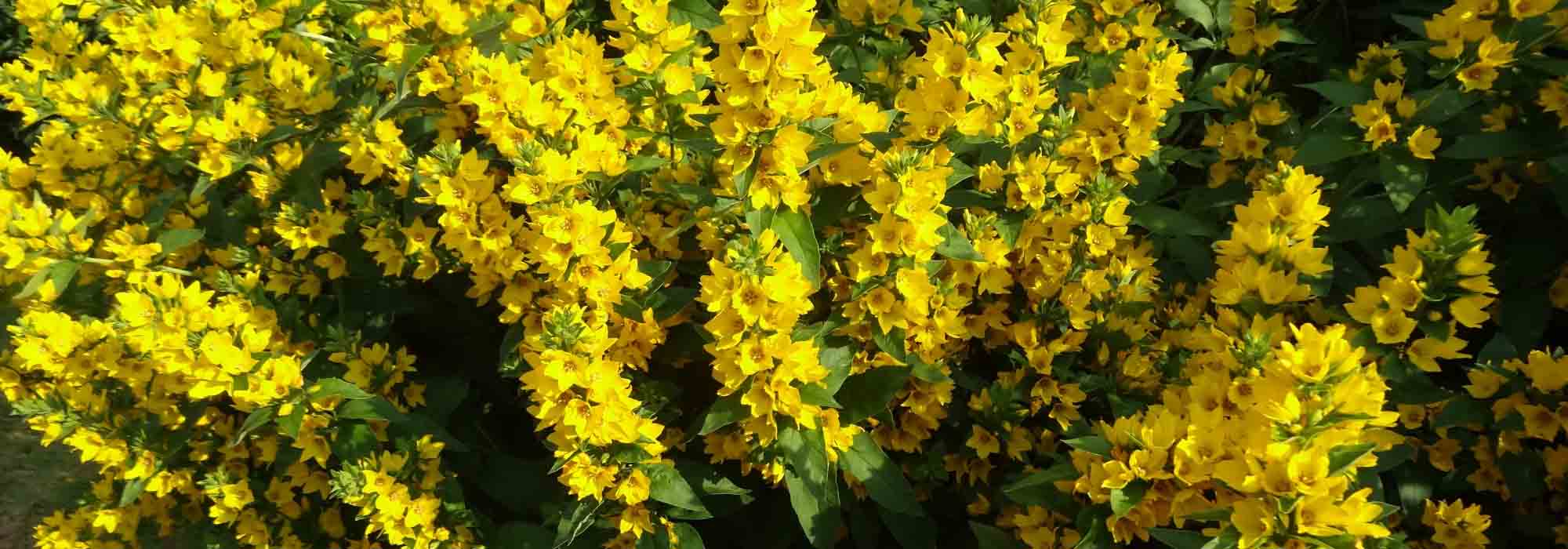
Lysimachia: planting, care and propagation
Contents
Lysimachia in a nutshell
- Lysimachias are herbaceous perennials of moist media that prefer sunny positions.
- Very floriferous, they flower for a long time in yellow, white or purple throughout summer.
- Lysimachias are very luminous thanks to their flowers and/or their foliage.
- Of varied height and habit, there are both groundcover lysimachias and erect lysimachias to brighten the back of a border.
- Easy to grow and vigorous, they suit beginners.
A word from our expert
When people talk about Lysimachia, they picture those star-shaped yellow flowers borne on tall upright stems. These are ideal for brightening the back of a border thanks to their abundant, luminous yellow flowers. But Lysimachia are much more varied than commonly thought. There are Lysimachia with a tapetum habit while others have flowers in white or purple spikes. Foliage colours are also diverse, such as the silver foliage of Lysimachia ephemerum or the foliage coloured in autumn of Lysimachia barystachys. Thus every garden style can find a Lysimachia to suit it. It is important to plant them on fresh or even moist soil throughout the year because they do not tolerate drought.
Vigorous and easy to grow, cultivation of Lysimachia is accessible even to beginners. One precaution: choose species carefully as some can be invasive. We are here to help you!

Description and botany
Botanical data
- Latin name Lysimachia sp.
- Family Primulaceae
- Common name loosestrife, moneywort, creeping Jenny, yellow loosestrife
- Flowering May to August
- Height 5 cm to 1.20 metres
- Exposure sun or sometimes partial shade
- Soil type rich and above all always fresh, even moist. All pH depending on species.
- Hardiness -7°C to -30°C
Loosestrifes (Lysimachia in Latin) are hardy herbaceous perennials of the Primulaceae family. All appreciate particularly cool, even damp habitats.
Origin of name Lysimachia is uncertain but probably Greek, perhaps referring to a king or a physician in antiquity.
In English, lysimaque jaune is called yellow loosestrife, which highlights resemblance of some species to marsh plants. Some species have very floriferous erect stems, one with yellow flowers (common loosestrife) and another with pink flowers, the purple loosestrife.
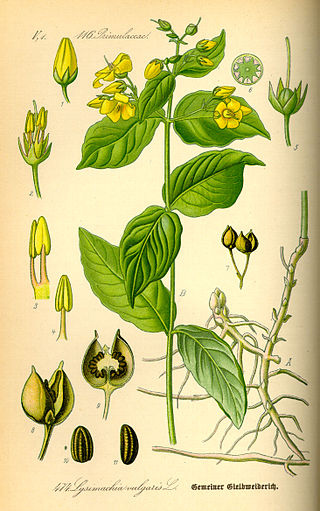
Native to temperate regions of northern hemisphere, mainly Europe and Asia, they are very hardy. Hardiness ranges from -7°C to -30°C. With more than 150 different Lysimachia species, they display great diversity of flowers, colours, habit and leaves.
Loosestrifes occur with erect habit, in clumps or creeping habit, with white, yellow or pink flowers. They flower between June and September. Note white flowering of Lysimachia clethroides while Lysimachia Beaujolais blooms wine-coloured. Flowers may be star-shaped, solitary or grouped in whorls, spikes or clusters. Flowers are appreciated by pollinating insects such as butterflies and other pollinators. Largest loosestrifes reach up to 1.20 metres like common loosestrife; smallest are under 10 cm tall with a mat-forming habit such as Lysimachia nummularia, also called moneywort. Taller species are ideal for creating a bright mixed border background, while mat-forming species make excellent groundcover for damp areas. Erect species can also be used in fresh-cut flower arrangements.
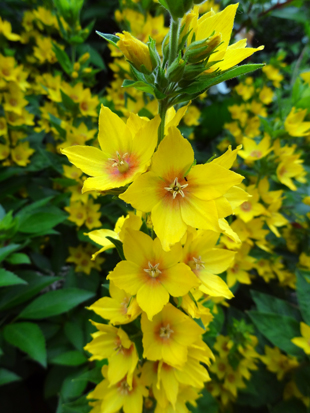
Lysimachia punctata
Foliage of loosestrifes is deciduous or evergreen, opposite or whorled depending on species. Leaves vary widely in shape and size. They may be soft green, golden, silvery, variegated or purple. Lysimachia ephemerum, or willow-leaved yellow loosestrife, is one of the most ornamental with silvery foliage and white flowers.
All appreciate rich, above all constantly fresh or moist soils. They particularly enjoy borders of ponds, woodland edges or wet meadows. Regarding soil pH, they tolerate almost all pH levels and even ericaceous soils.
Used as ornamental plants in gardens, they suit natural gardens as well as landscaped or contemporary gardens.
Easy to grow, some loosestrifes can nonetheless become invasive. They develop a rhizomatous rootstock that spreads rapidly and is hard to remove. Indeed, spotted loosestrife, Lysimachia punctata, has naturalized so well in France that it is considered naturalized.
As for common loosestrife, Lysimachia vulgaris, very invasive, it is declared invasive in some countries.
Botanical species of loosestrife
- Common loosestrife, great yellow loosestrife or kinkweed, Lysimachia vulgaris
This botanical species is probably most suitable for natural gardens and pond margins. Vigorous and fast-growing, it quickly colonises space, creates an attractive mass effect and stabilises pond banks. It flowers bright yellow on upper third of its tall erect stems. Small cup-shaped flowers measure only 2 cm across but flowering is long and abundant. This species is particularly invasive. When planting, it is advisable to use a rootstock barrier (thick, resistant polypropylene film) to restrict spread.
- Spotted loosestrife, Lysimachia punctata
This robust perennial is recognised by its clusters of bright yellow flowers arranged in successive tiers. Undemanding, it tolerates all exposures provided soil remains cool year-round. Like common loosestrife, this species sends out many suckers in heavy, wet soils.
Our favourite Lysimachia varieties
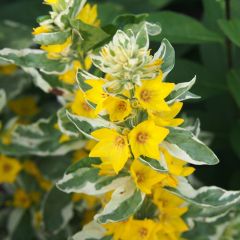
Lysimachia punctata Alexander - Loosestrife
- Flowering time August, September
- Height at maturity 70 cm
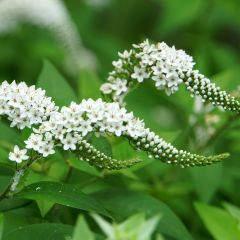
Lysimachia clethroides - Loosestrife
- Flowering time August, September
- Height at maturity 70 cm
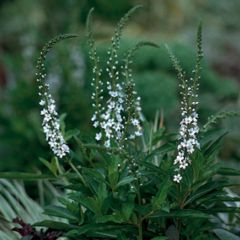
Lysimachia fortunei - Loosestrife
- Flowering time August, September
- Height at maturity 80 cm
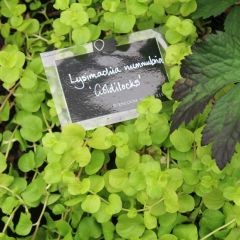
Lysimachia nummularia Goldilocks - Creeping Jenny
- Flowering time July to September
- Height at maturity 8 cm
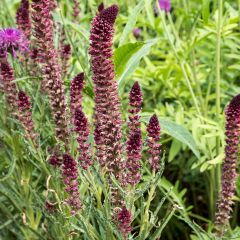
Lysimachia atropurpurea Beaujolais - Loosestrife
- Flowering time July, August
- Height at maturity 80 cm
Discover other Lysimachia
View all →Available in 1 sizes
Available in 2 sizes
Available in 1 sizes
Available in 2 sizes
Available in 1 sizes
Available in 1 sizes
Available in 1 sizes
Available in 1 sizes
Available in 3 sizes
Available in 1 sizes
Planting Lysimachia
When to plant Lysimachia?
Plant your Lysimachia plants preferably in autumn or spring. In autumn, plants have time to establish during winter: this wetter period favours establishment of your Lysimachia plants.
Where to plant Lysimachia?
Lysimachia plants prefer full sun, although some varieties tolerate partial shade. They are planted at woodland edge, by ponds, in a damp meadow or in a cool, sunny border.
They appreciate rich soil that remains cool to moist. On dry soil, Lysimachia plants will be smaller and more compact. They tolerate humus-bearing to clayey soils, even heavy ones. They accept soil with a neutral to slightly acidic or alkaline pH.
Hardy from -7°C to -25°C depending on variety, they can be planted almost anywhere in France.
They suit contemporary, natural or English gardens equally well.
Planting Lysimachia in open ground
Depending on size of chosen Lysimachia, plant 3 to 5 plants per m².
- For Lysimachia supplied in rootball, immerse rootballs while preparing soil.
- Dig a hole three times the size of the rootball or five times the size of your rootstock.
- Some Lysimachia can be invasive, especially at pond edges where moisture is constant year-round. To prevent this, install a rootstock barrier.
- If soil is poor, mix garden soil with 50% compost or potting compost.
- Place the rootball level with soil or position rootstocks 25 cm deep.
- Backfill with your soil mix.
- Water abundantly.
- Mulch around the plant to reduce watering needs and keep soil cool for longer.
Water during first years after planting.
Planting Lysimachia in a pot
Because Lysimachia like rich, cool to wet soils, prepare a rich substrate that retains water well. For this, choose a potting compost for flowering plants to which you add a few handfuls of sand. In small proportion, sand helps water retention.
Choose a pot large enough for your rootstocks to be positioned in a hole 25 cm deep. Lysimachia grow quickly and will fill the pot.
During first years after establishment, water well. Then, water only to keep soil consistently cool to moist year-round. Soil must not dry out between waterings.

Planted in sun or partial shade, in rich, cool to moist soil, the Chinese loosestrife is an easy plant that grows steadily.
Read also
Hosta: planting, growing and careCaring for your lysimachias
Easy to grow, Lysimachias require little maintenance and are not very susceptible to disease. They can be perfectly grown by novice gardeners.
At the end of winter, start by cutting all dead stems back to ground level if still present. New shoots for the year can then grow freely. Slugs can attack young shoots — prevent slug attacks. For more information: 7 ways to fight slugs effectively and naturally.
When growth resumes in spring, top-dress with compost to feed the plant. For upright-habit Lysimachias, if stems are too tall or not bushy enough, pinch them to reduce height and encourage branching.
As flowering progresses, remove faded flowers or cut spent stems back to ground level. This prevents the plant using energy to produce seed rather than to flower. By preventing seed formation, you also stop the plant self-seeding and producing new plants all over the garden.
In summer, water and mulch the base of your Lysimachias to keep soil cool. Maintaining moisture is essential for good flowering. Mulching reduces watering frequency. Soil should never dry out between waterings as Lysimachias do not tolerate drought.
In winter, cut back deciduous Lysimachias to ground level once they have lost all ornamental interest. This pruning is carried out between January and March.
To maintain vigour, divide the rootstock into several pieces every 5–6 years. For very vigorous clumps, restrain the plant by removing invasive parts with a spade.
Caring for Lysimachia in a pot
For a potted Lysimachia, give these additional care steps:
- Repot every year at the start of spring using potting compost for flowering plants.
- From April until end of flowering, apply liquid feed for flowering plants with your waterings.
- Water so that the compost never dries out completely.
- Mulch the pot to retain moisture as long as possible and reduce watering.
Propagating your Lysimachia
Dividing Lysimachia
Although propagation by cuttings and sowing work to multiply Lysimachia, division has advantage of being faster and produces same variety as parent plant. Division is possible if plant is well established. It is carried out in spring or autumn.
To divide Lysimachia, follow steps below.
- With fork and spade, lift entire Lysimachia rootstock.
- With spade, divide rootstock into several pieces.
- Plant each piece about 25 cm deep in a hole 5 times wider than rootstock size.
- Fill hole with garden soil mixed with 50% compost or potting soil.
- Water thoroughly.
- Mulch to conserve soil moisture and reduce need for watering.
Sowing Lysimachia
Sowing is possible but can be very slow. Proceed as follows:
- Sow on seed compost between February and July.
- Keep compost moist with continuous watering, maintain humidity by placing a plastic bag over. Temperature should be kept between 18°C and 25°C. Germination varies between 1 and 4 months.
- When young plants are large enough for 8 cm pots, pot them on.
- Acclimatise young plants to outdoor conditions in partial shade when temperatures are mild.
- Plant in sun or partial shade in rich, loose and cool soil.
Good to know: Lysimachia sold as seeds are sometimes short-lived cultivars (1 to 2 years). They are grown almost like annuals.
Companion planting with Lysimachia
We often plant lysimachias in partial shade to ensure they stay consistently fresh. Create a partial-shade border with lysimachias, pair them with alchemillas, hostas, astilbes, aruncus or ferns.
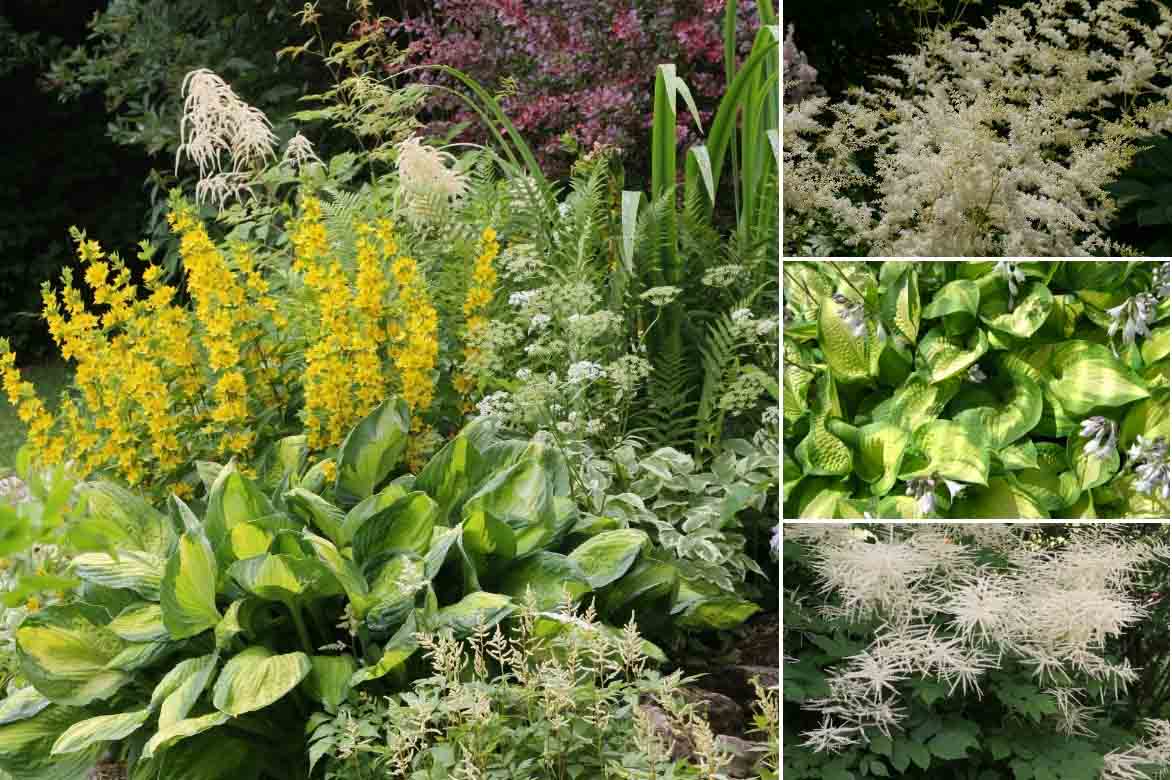
Combine Lysimachia punctata from bottom to top in the border: Astilbe simplicifolia Darwin’s Snow Sprite (first photo on the right), Hosta Paul’s Glory (second photo on the right), then the white spikes of Aruncus dioicus sylvestris (third photo on the right) and the purple foliage of Berberis thunbergii atropurpurea.
In sunny spots, lysimachias harmonise with rhubarb, garden angelica, Oriental poppies and foxgloves.
For pond margins, lysimachias pair wonderfully with plants of wet ground: purple loosestrife, marsh mallows, meadowsweet, filipendulas, primulas with nival zone, horsetails, geraniums such as Geranium psilostemon or even a shrub like Salix integra ‘Hakuro Nishiki’.
As for lysimachias with creeping habit such as Lysimachia nummularia Goldilocks, they create an ideal groundcover in a cool rockery or at pond edges. In pots, create a striking floral composition with annuals such as blue lobelias, mauve and violet petunias or the purple foliage of ipomoeas.

Golden, groundcover foliage of Lysimachia nummularia Goldilocks with blue flowers of lobelias (Lobelia Hot Royal Blue) and purple foliage of Ipomoea Illusion Midnight.
→ Discover other ideas for pairing lysimachias in our care sheet
Did you know?
Lysimachia species are also known for medicinal and dyeing uses.
Common loosestrife, also called great loosestrife (Lysimachia vulgaris), is reputed for wound‑healing and astringent properties. This earned it the name chasse‑bosse. Yellow flowers of loosestrife are used to obtain a yellow dye, while their roots yield a brown dye.
Useful resources
-
- Our complete Lysimachia collection
- Our tips for varying and mixing shapes in your flower borders
- Our planting advice for perennials and bushes
- Discover our 7 pairing ideas to create beautiful summer planters
- Subscribe!
- Contents
































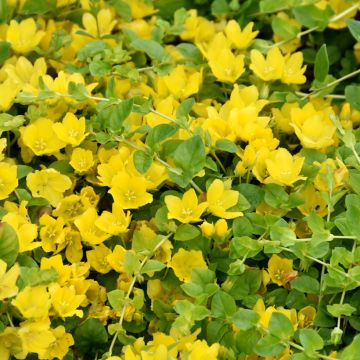

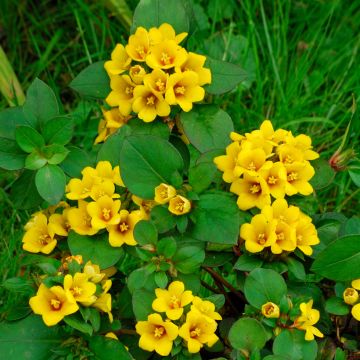
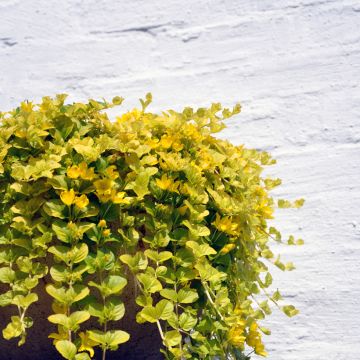

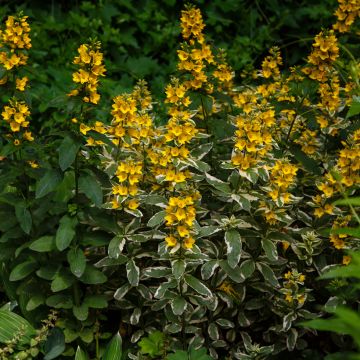

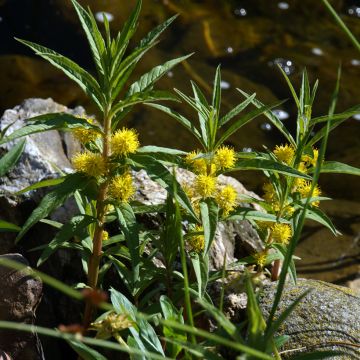
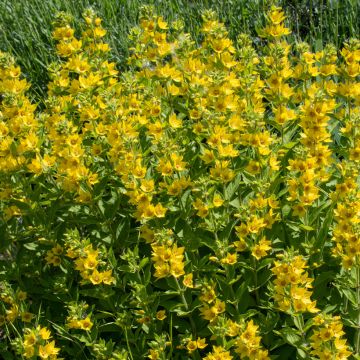
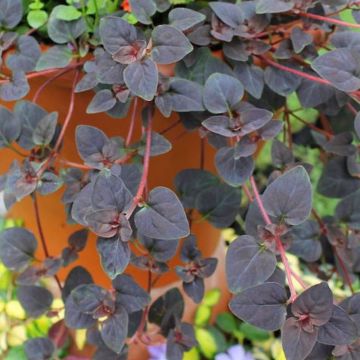
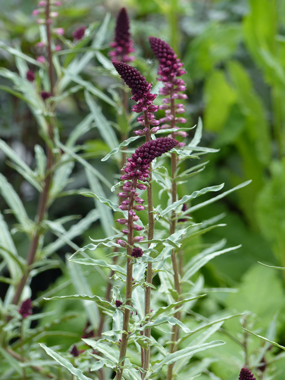
Comments